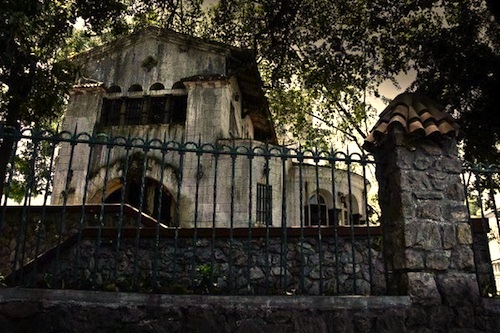By Joe Bendel. Like many Venezuelans, Dulce has spent long years in prison for crimes she did not commit. However, she is not a political prison. She was simply blamed for the supernatural tragedy that unfolded in her house. Considered the first Venezuelan horror movie, Alejandro Hidalgo’s The House at the End of Time had fans sit up and take notice during the 2014 Fantasia International Film Festival.
The audience will get numerous added perspectives on what exactly happened that night, but one thing is certain. Dulce’s husband Juan José was stabbed to death. There were not a lot of other suspects to be found, especially not their eldest son Leopoldo, who seemingly vanished without a trace. Convicted of both their presumptive murders, Dulce eventually is granted a supposedly humanitarian release. However, the terms of her parole require her confinement in the very house where she endured those horrors.
As Hidalgo flashes back in time, we witness an earlier night of terror that thoroughly destabilizes Dulce’s family. Clearly, some strange agency is at work, but Juan José and the cops are quick to dismiss Dulce. Frankly, the only person who ever believes her is the sympathetic parish priest, who tries to counsel the older Dulce her during her house arrest. Researching the evil looking domicile, he discovers it was specially constructed by a mysterious English Mason. Over time, the state took possession of the house, offering it to low income families, but never revealing its macabre history.
House starts out as a decidedly atmospheric horror movie, but it evolves into a genre-defying, reality-bender. It is a far more complex narrative than viewers will initially suspect, but Hidalgo marshals the assorted strands quite adroitly. It is also rather refreshing to see an uplifting portrayal of a Catholic priest, with the ultra-subtle implication of government bureaucratic disregard for public welfare being a nice added bonus.

Former Miss Venezuela Ruddy Rodríguez glams down rather boldly to play Dulce. Far from a heroic mother figure, it is a full-fledged, emotionally complicated performance. Guillermo García also raises the good Father above a mere symbol of decency. However, the younger cast-members can be a bit awkward on-camera.
Of course, one of the biggest stars is that creepy old house, which art director Evadne Mullings decks out in lovingly dark detail. There must be more keys in House than any other film playing at Fantasia (all those locked doors seem like a fire hazard, but they well serve Hidalgo’s tense narrative). Cinematographer Cezry Jawkorski’s gives it all a moody, morose look that heightens the foreboding. It all works surprising well, raising the stakes for the old dark house movie. Recommended for genre fans, The House at the End of Time was one of the pleasant surprises at this year’s Fantasia.
LFM GRADE: B+
Posted on August 8th, 2014 at 1:32pm.